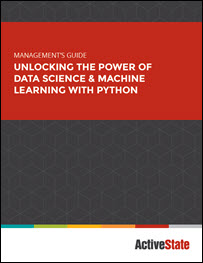Data science and machine learning have emerged as the keys to unlocking value in enterprise data assets. Unlike traditional business analytics, which focus on known values and past performance, data science aims to identify hidden patterns in order to drive new innovations. Behind these efforts are the programming languages used by data science teams to clean up and prepare data, write and test algorithms, build statistical models, and translate into consumable applications or visualizations. In this regard, Python stands out as the language best suited for all areas of the data science and machine learning framework.
In a recent white paper “Management’s Guide – Unlocking the Power of Data Science & Machine Learning with Python,” ActiveState – the Open Source Language Company – provides a summary of Python’s attributes in a number of important areas, as well as considerations for implementing Python to drive new insights and innovation from big data.
When it comes to which language is best for data science, the short answer is that it depends on the work you are trying to do. Python and R are suited for data science functions, while Java is the standard choice for integrating data science code into large-scale systems like Hadoop. However, Python challenges Java in that respect, and offers additional value as a tool for building web applications. Recently, Go has emerged as an up and coming alternative to the three major languages, but is not yet as well supported as Python.
In practice, data science teams use a combination of languages to play to the strengths of each one, with Python and R used in varying degrees. The guide includes a brief comparison table highlighting each language in the context of data science.
Companies are not only maximizing their use of data, but transforming into ‘algorithmic businesses’ with Python as the leading language for machine learning. Whether it’s automatic stock trading, discoveries of new drug treatments, optimized resource production or any number of applications involving speech, text or image recognition, machine and deep learning are becoming the primary competitive advantage in every industry.
[clickToTweet tweet=”Companies are transforming into ‘algorithmic businesses’ with Python as the leading language for machine learning. ” quote=”Companies are transforming into ‘algorithmic businesses’ with Python as the leading language for machine learning. “]
In the complete white paper, ActiveState covers:
- Introduction: the Big Data Dilemma
- Python vs. Other Languages
- Data Analysis with Python
- Machine Learning with Python
- Recommendations
To learn more about introducing Python into your data science technology stack, download the full white paper.






Speak Your Mind